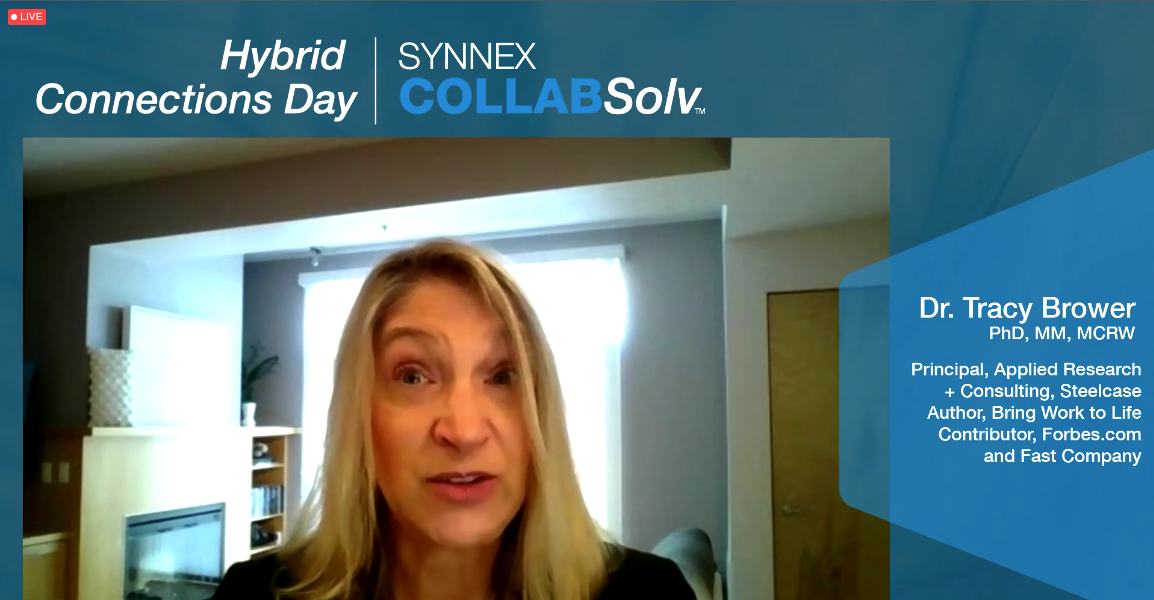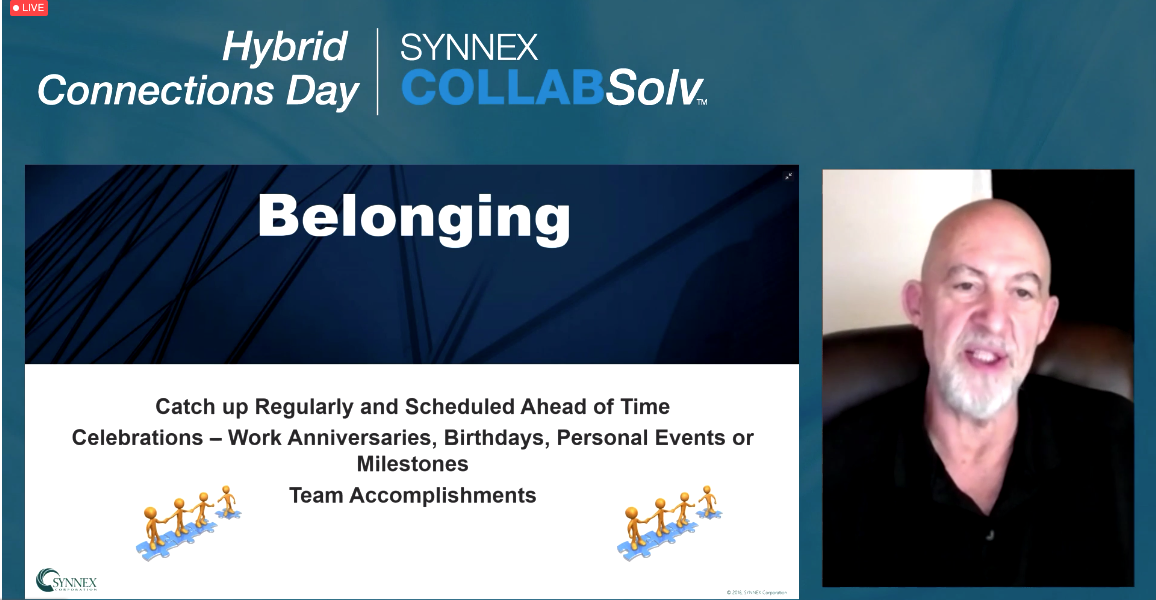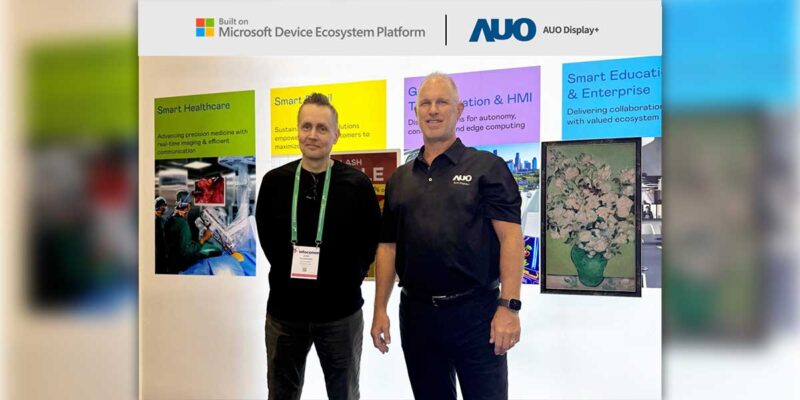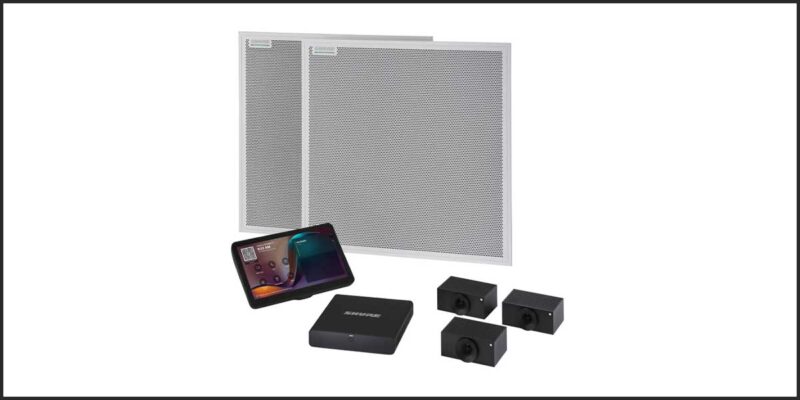What’s Next for 2020-21? Learnings from SYNNEX’s Latest of the LAVNCH Days

Thursday marked the third of the SYNNEX COLLABSolv LAVNCH Days (if you need reference material as to what those are, find some previous coverage here), and this event in particular promised to cover a topic at the forefront of all our minds: hybrid connections.
What are they? What do they look like in our homes? In our classrooms? In our minds?
Three engaging sessions on SYNNEX COLLABSolv Hybrid Connections Day dived into these thought-starters. Read on for our coverage of the event.
Thanks, and enjoy the show.
Surviving and Thriving During the Pandemic: How to Stay Engaged and Engaging
The day’s keynote speaker was Dr. Tracy Brower, author of “Bring Work to Life by Bringing Life to Work: A Guide for Leaders and Organizations” (which focuses on work-life fulfillment). Dr. Brower is also principal of Applied Research + Consulting (ARC) at Steelcase, and we even got a chance to talk to her before Thursday to get a preview of her expertise and knowledge.
Kicking off the session, Dr. Brower said: “I believe this will be the most significant reinvention of work in our time.”

Working from home brings so many challenges — social isolation is one of them. It’s important to be aware of that reality so we can get through it together, Dr. Brower reaffirmed us.
Her first question to the audience: To what extent has your wellbeing been compromised through the pandemic? Dr. Brower likened this to being on a boat — it’s all really fun, but there are ups and downs throughout the experience. Just when we think we have it figured it out, with the light at the end of the tunnel, something happens. There’s been a real ebb and flow to this pandemic, with differences to our wellbeing over time.
Wellbeing is holistic too, Dr. Brower continued. It has to do with our thought process — our brain is hard at work responding to “fight or flight,” and what we’re facing today is perceived as threat and danger. For instance, we can often lose track of what day it is these days. Being on camera all the time is draining. These factors are disorienting and can cause us to lose sense of time.
But, “By goodness, we will get through this together,” Dr. Brower exclaimed.
It turns out there are some positive effects of stress too: gaining perspective, enhancing creativity, finding new experiences and growing our resilience — taking in today’s reality, making sense of it, and employing improvisation and response techniques. This can be seen through the MacGyver effect — the epitome example of humans’ improv and response and knowing how to pull through tough times — Dr. Brower explained. She continued: Studies show that when people have small doses of difficulty over time, they are overall more resilient. This is like a muscle that we develop — it can actually make us stronger. There’s an opportunity here to assess our own levels of resilience in helping both ourselves and our colleagues and friends.
How do we become engaged and take advantage of that stress? One way is by leveraging connections. We are social “herd” animals. There’s strength in numbers. Dr. Brower suggests being social however you can these days — making as many connections with others as possible. Another strategy we can take up? Routine. Humans crave certainty, clarity and patterns.
“People don’t trust what they don’t understand,” Dr. Brower explained.
Through this pandemic, there’s been extra friction — having to remember our mask for everyday errands, for example. Additional friction requires more energy. The more pattern and routine we have, the more mental energy we have for engaging and connecting.
Another strategy is to be altruistic. What this means is thinking about others, giving to others and being concerned about others — which, turns out, is actually really good for our own mental health. People who report being more generous — like volunteering regularly — report being happier, more engaged at work and feeling better generally. Benefits include meeting more people, building up our networks and even making more money, Dr. Brower added.
Some final uplifting tips and takeaways provided:
- Be engaging
- Be fearless
- Be confident
- Be optimistic
- Be authentic
- Be forgiving
If anything, we’ve all got nothing to lose from trying these out — they could, in fact, help us live longer!
Maintaining Connection in Hybrid Environments
Next up for Hybrid Connections Day was a panel with SYNNEX vendors Lenovo, Microsoft, Ribbon and RUCKUS. Jennifer Ryerson was our moderator.
“We’ve seen a shift from hardware to solutions you can access from the cloud.” – Greg from Ribbon talking about changing needs of users as a result of #COVID19.
Who’s tuned into @SYNNEX COLLABSolv Hybrid Connections Day? #AVtweeps #AVisLIFE pic.twitter.com/utTObmTeLc
— rAVe [PUBS] (@rAVePubs) October 8, 2020
Panel participants and a few takeaways:
- Brian Mignault (Lenovo): For Mignault, it’s all about the partner community — 90% of Lenovo business goes through the North American channel, Mignault said. Even Lenovo continues working hard every day to build the right relationships within the ecosystem in the ProAV space. What enables this? Partnerships.
- Greg Zweig (Ribbon): Zweig said the new hybrid environment, brought forth by COVID-19, gives partners a new opportunity to go in and have new customer conversations. It has offered a way to pull in the full manufacturer ecosystem too — the RUCKUS wireless device or Poly headsets, for instance. Why? Customers are now looking for new ways to do things through technology.
- Augie Pena (SYNNEX, representing RUCKUS): The first thing people consider for an at-home workforce is reliable Wi-Fi. RUCKUS Cloud helps IT manage an increasingly complex network environment with existing IT resources. RUCKUS is working with reseller partners like SYNNEX to deliver equipment straight to residential locations, with solutions that can be deployed and managed all remotely.
- Renee Abrams (Microsoft): Abrams spent time talking about the value propositions of the Microsoft Surface Hub, an all-in-one collaboration solution, and various evolutions of it — like a portable cart system that doesn’t tie you to using the Hub in just one location. Another opportunity Abrams is seeing is bringing the Microsoft Teams operating system and the Hub to people’s own devices. For industries like healthcare and education and courtrooms, where it’s all about connection, this has been impactful.
This was a lively panel that touched on the core of the hybrid environment we live in today — connections. Interested in learning more? Just reach out to SYNNEX’s vendor partners above or catch some of their live demos by registering and logging into this SYNNEX event (catch the link at the bottom of this article).
Team Building from a Distance
Our final event of the day, the SYNNEX Value session, was led by Mike Fleetwood. The topic: strengthening your team from a distance.
Keeping up spirits — no pun intended even though it’s October — with a dispersed workforce: What a challenge, right?
I think of a quick example for myself: Half of us probably love organized virtual happy hours with our work teams, while the other half just want to get off the dang computer at the end of a long workday.

Fleetwood led with an example on the power of thought process by American psychologist Dr. William Glasser: For one, we want to be the one delivering the good news (which can be quite tough and tricky these days). And we all strive for belonging. Lastly, Fleetwood continued, we want to have FUN (not just fun — but FUN).
A few traits that leadership can build up within teams:
- Belonging — don’t assume people are just free all the time. Team-building means people coming with the right mind and thought process to contribute to events. That takes planning on the organizer’s end.
- Power — “share the stage” with employees of all levels. It’s not what “I” have done but what “we” have done. A united team achieves more and empowers individual employees.
- Freedom — give employees a chance to — or not to — contribute. Either way, employees need to feel valued within the group dynamic. The usual leader’s way may not always be the best way, Fleetwood offered. Note that work/project quality can always be improved, which allows us the freedom to constantly evaluate and reevaluate and reevaluate again. And, while creativity is all fun and good and well, it needs direction and alignment on the goals and outcomes — and people need space and autonomy to be creative.
- FUN — Fleetwood suggests you don’t want to push “fun” in the team-building format in a way that alienates someone or makes them feel less of a contributor within the team. Recognize people individually, within individual events, then recognize them as part of the team in team events. This takes an understanding of what is an individual event and what is a team-building event.
Some additional ideas Fleetwood offered to promote fun:
- Virtual travel sharing
- Virtual background contests
- Favorite virtual story
- “Guess who?” sharing events
- Virtual lunch & learns
So are those virtual happy hours I mentioned earlier “fun” in Fleetwood’s opinion? Yes. But let people talk about things other than work in them — maybe you set it up as a wine tasting or just talk about what you ordered on Grubhub that day.
Enjoy this SYNNEX COLLABSolv Hybrid Connections Day recap? You can register to view the archives here. The next of the SYNNEX COLLABSolv LAVNCH Days, called “Top Tech Day” will take place Dec. 2. Keep an eye open for registration on SYNNEX’s Twitter page and at https://theraveagency.com/lavnch-days/synnex-collabsolv.





